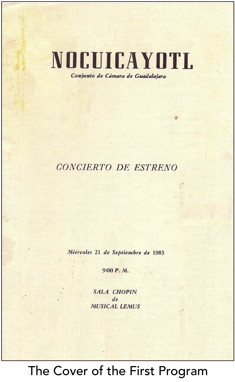Clicking on any of the above names takes you to that composer’s page on our website.
The Story of Nocuicayotl.
Mexican orchestras during the late 1970s and early 1980s represented an attractive alternative for American (and other foreign) musicians who were seeking gainful employment in a difficult field. Not only were these full time opportunities, but because of a favorable exchange rate it was possible to live relatively comfortably. Along with the major orchestras in Mexico City, there were also fine orchestras in Xalapa, Toluca, Guadalajara and in other cities.
So it was that a young oboist (me) fresh out of graduate school found himself in Guadalajara’s symphony orchestra. Although the orchestra’s conductor was described in the press as “low voltage,” it was, nevertheless, not a bad place to be. Furthermore, the repertory was challenging and the orchestra did a season of opera every summer, all to good effect.
The young oboist developed a number of important relationships, and because of this, in July 1983, with the very generous support of a civil engineer, Lino Vite Saldaña, was able to organize a professional chamber music ensemble that consisted of himself, as well as flutist Christine Nazzi, violinist Aurelian Ionescu, violist Hans Bodendorfer, cellist Marek Karwowski and pianist Shari Weiner. The ensemble’s name, Nocuicayotl, is an amalgam of three Nahuatl words, chosen in deference to the indigenous people who lived in the region in and around Guadalajara and who remain there still. The syllable “No” means “my” or “our;” “cuicatl” means “song;” and though the suffix “yotl” has no exact equivalent in English it suggests the enduring and divine origin of a thing.
The group gave its first performance on September 21, 1983, in the Chopin Auditorium of Musical Lemus, which is a prominent music store in Guadalajara. The program consisted of music by Boccherini, Cirri, Quantz and Stamitz. The group continued to perform concerts throughout the end of that year and into 1984. However, during 1984 Mexico suffered a grave economic crisis. The government nationalized the banking system in that country and the peso was devalued by about half. By about mid summer the value of orchestra wages had diminished to about 25% of their previous level. Because the young oboist, along with other players, decided to leave the symphony, the sextet turned out to be not so enduring.
In hindsight, it’s rather ironic that a group took for its name an indigenous word when not only were all of its members foreigners, but that the ensemble never played a single Mexican composition. (So many years later it is difficult to recall if this was ever a consideration). Although Mexican chamber works did exist at that time, these were simply not to be found. The only certain thing about this is that the chamber music sitting on the shelves of music stores in Guadalajara and Mexico City in 1983 was by European composers.
|
|
For more information about the music of this country, including links to conservatories, university music departments and other institutes and organizations, please see our country resource page for Mexico.
 Would you like to learn about our various projects and activities? How about what our composers are doing around the world? Yes? Then be sure to sign up for our monthly newsletter, the Cayambis Connection. Subscribers get special promotions and discounts, too. Would you like to learn about our various projects and activities? How about what our composers are doing around the world? Yes? Then be sure to sign up for our monthly newsletter, the Cayambis Connection. Subscribers get special promotions and discounts, too.
|
|
|


